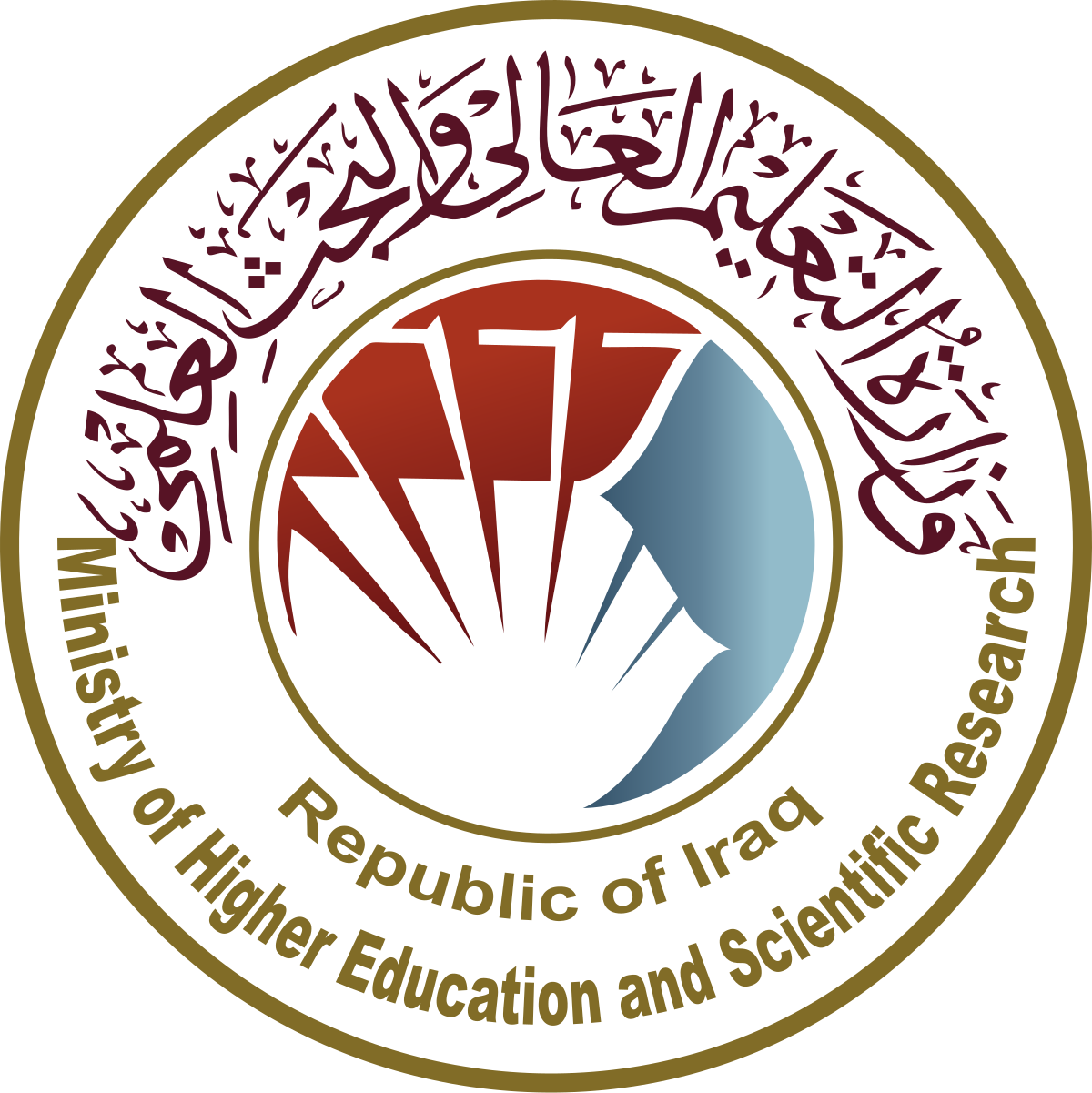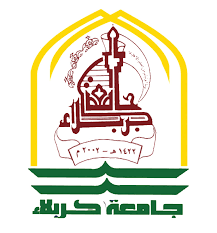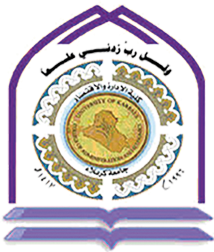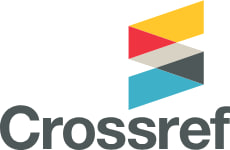التفكير الستراتيجي وتأثيره في الأداء الإبداعي
بحث استطلاعي تحليلي لآراء عينة من منتسبي قسم شؤون البطاقة الوطنية الموحدة في كربلاء المقدسة
الكلمات المفتاحية:
التفكير الستراتجي، الأداء الإبداعيالملخص
هدف البحث الى معرفة مدى امكانية تأثير أبعاد المتغير المستقل التفكير الستراتجي المتمثل بـ (القصد الستراتجي، التفكير بالوقت، الفرضيات الموجهة، التفكير القرصي والتفكير النظمي) والمتغير المعتمد الأداء الإبداعي بأبعاده المتمثلة (المرونة، الطلاقة، الاصالة والاحساس بالمشاكل) في قرارات ضباط وموظفي قسم شؤون البطاقة الوطنية الموحدة في كربلاء المقدسة التي أجريت البحث فيها.
اعتمد البحث على المنهج الوصفي الاستطلاعي في جمع وتحليل بياناته وتفسيرها، واعتمدت استمارة الاستبانة كأداة رئيسة في جمع البيانات من عينة بلغت (70) موظفاً من القسم المبحوث فضلاً عن اجراء المقابلات الشخصية لعدد من الضباط رتبة رائد فما فوق ومدراء الأقسام والشعب وتم استخدام مجموعة من الأساليب الإحصائية التي ساعدت على تحليل بينات البحث واختبار فرضياته والمتمثلة بـ أدوات إحصائية (شملت التكرارات، طريقة (Boxplot) إحصاءه (Kurtosis and Skewness) لإثبات صحة التوزيع الطبيعي للبيانات، التحليل العاملي التوكيدي، معامل ألفا كورنباخ، المتوسطات الحسابية والانحرافات المعيارية، معامل الارتباط بيرسون (Pearson Correlation)، معامل التحديد (R2)، واختبار (T)، بالاعتماد على البرامج الإحصائية الجاهزة ((SPSS.V. 23.
وتوصل البحث الى مجموعة استنتاجات أهمها الادراك المرتفع لمتغيرات البحث الحالي من قبل المنظمة عينة البحث، والارتقاء بالمنظمة والوصول الى مراكز تنافسية مرموقة وتكوين منظومات ارشادية توظف عن طريق برامج تدريبية تطور وترسخ في أذهان القيادات والموارد البشرية طبيعة العلاقة التفاعلية بين متغير التفكير الستراتجي واستخدامه لبناء أداء ابداعي للأفراد ، واختتم البحث بجمله من التوصيات التي تسهم في توضيح العلاقة بين متغيرات البحث وأبعاده ووضع وسائل وأليات يمكن تطبيقها على واقع المنظمة المبحوثة ونشر ثقافة التفكير الستراتجي في جميع مفاصل وأقسام المنظمة .
المراجع
يونس، طارق شريف، (2002) الفكر الستراتجي للقادة، المنظمة العربية للتنمية الإدارية، جامعة الدول العربية، القاهرة، مصر.
ب - المجلات الدوريات المؤتمرات :
قويع خيرة، ودباحي يمينة، وسليمان عائشة، (2018). الابداع التنظيمي كمدخل لتحقيق ميزة تنافسية للمؤسسة، دراسة حالة مؤسسة المطاحن الكبرى للظهرة مستغانم.
ت- الرسائل والاطاريح الجامعية:
العبيدي، ارادن حاتم خضير، ((2010 تقانة المعلومات والتفكير الستراتجي وتأثيرهما في استراتيجية الابداع التنظيمي، دراسة تطبيقية في كليات الجامعة المستنصرية، أطروحة دكتوراه غير منشورة، فلسفة في الدراسات المستقبلية، كلية الإدارة والاقتصاد الجامعة المستنصرية، بغداد.
A- Books
El Namaki, M. S. S. (2014). Strategic Thinking for Turbulent Times. Springer.
Dewberry, C. (Statistical Methods for Organizational Research:Theory and practice) First published, Published in the Taylor & Franci, 2004.
Saunders, M., Lewis, P., & Thornhill, A. (2009). Research methods for business students. Essex. Financial Times/Prentice Hall.
Hair, J, Huult, T, Ringle, C, and Sarstedt, M. (2017). A primer on partial least squares structural equation modeling (PLS-SEM). Los angeles: Sage.
B- Journals&periodicals&researchas
Liedtka, J. M. (1998). Strategic thinking: can it be taught?. Long range planning
Baloch, Q. B., & Inam, M. (2007). Strategic thinking: Catalyst to competitive advantage. Journal of Managerial Sciences.
Taylor, A. S. (2015). Transformational leadership, diversity, and creativity at work: A moderated mediation model
Alatailat, M., Elrehail, H., & Emeagwali, O. L. (2019). High performance work practices, organizational performance and strategic thinking. International Journal of Organizational Analysis.
Dhir, S., Dhir, S., & Samanta, P. (2018). Defining and developing a scale to measure strategic thinking. Foresight.
Nickols, F. (2016). Strategy, strategic management, strategic planning and strategic thinking. Management Journal.
Lee, H. W., & Yu, C. F. (2010). Effect of relationship style on innovation performance. African Journal of Business Management.
Salamzadeh, Y., Bidaki, V. Z., & Vahidi, T. (2018). Strategic Thinking and Organizational Success: Perceptions from Management Graduates and Students. Global Business & Management Research.
Peleckis, K. (2015). Strategic management schools and business negotiation strategy of company operations. Ekonomia i Zarządzanie.
Ershadi, M. J., & Dehdazzi, R. E. (2019). Investigating the role of strategic thinking in establishing organizational excellence model. The TQM Journal.
Goldman, E. F., Schlumpf, K. S., & Scott, A. R. (2017). Combining practice and theory to assess strategic thinking. Journal of Strategy and Management.
Kollmann,t,stockman,c,krell,peschl,A&Buchwald,S.(2013).lntegratlng dependency on the leader and empowerment lnto transformatlonal leadershlp creatlve performance relatlonshlp . central European Business review.
Suifan, T. S., & Al-Janini, M. (2017). The relationship between transformational leadership and employees’ creativity in the Jordanian Banking Sector. International Review of Management and Marketing.
Jaiswal, N. K., & Dhar, R. L. (2015). Transformational leadership, innovation climate, creative self-efficacy and employee creativity: A multilevel study. International Journal of Hospitality Management.
Amjed, A., & Tirmzi, S. H. S. (2016). Effect of humor on employee creativity with moderating role of transformational leadership behavior. Journal of Economics, Business and Management.
Yeh, S. S., & Huan, T. C. (2017). Assessing the impact of work environment factors on employee creative performance of fine-dining restaurants. Tourism Management.
Sharifirad, M. S. (2016). Can incivility impair team’s creative performance through paralyzing employee’s knowledge sharing? A multi-level approach. Leadership & organization development journal.
Boselie, P. (2010). High performance work practices in the health care sector: a Dutch case study. International Journal of Manpower.
Purnomo, B. R. (2019). Artistic orientation, financial literacy and entrepreneurial performance. Journal of Enterprising Communities: People and Places in the Global Economy.
Zubair, A., & Kamal, A. (2017). Perceived Authentic Leadership, Psychological Capital, and creative work behavior in bank employees. Pakistan Journal of Psychological Research.
Petraite, M. (2014). Organizing and Monitoring Innovation: linking Processes, Design, and Strategy. In ISPIM Conference Proceedings (p. 1). The International Society for Professional Innovation Management (ISPIM).
Johannessen, J. A., & Skaalsvik, H. (2015). The development of innovations in organizations: The role of creative energy fields. Kybernetes.
Yazgan-Sag, G., & Emre-Akdogan, E. (2016). Creativity from two perspectives: Prospective mathematics teachers and mathematician. Australian Journal of Teacher Education (Online).
Awang, H., & Ramly, I. (2008). Creative thinking skill approach through problem-based learning: Pedagogy and practice in the engineering classroom. International journal of human and social sciences.
Rego, A., Sousa, F., Marques, C., & e Cunha, M. P. (2012). Authentic leadership promoting employees' psychological capital and creativity. Journal of business research.
Shujahat, M., Hussain, S., Javed, S., Malik, M. I., Thurasamy, R., & Ali, J. (2017). Strategic management model with lens of knowledge management and competitive intelligence. VINE Journal of Information and Knowledge Management Systems.
Avey, J. B., Luthans, F., Hannah, S. T., Sweetman, D., & Peterson, C. (2012). Impact of employees' character strengths of wisdom on stress and creative performance. Human Resource Management Journal.
Wu, Y. L., Li, E. Y., & Chang, W. L. (2016). Nurturing user creative performance in social media networks. Internet Research.
Song, J., Wu, J., & Gu, J. (2017). Voice behavior and creative performance moderated by stressors. Journal of Managerial Psychology.
Patterson, M., Warr, P., & West, M. (2004). Organizational climate and company productivity: The role of employee affect and employee level. Journal of occupational and organizational psychology.
Mylonas, N., & Petridou, E. (2018). Venture performance factors in creative industries: a sample of female entrepreneurs. Gender in Management: An International Journal.
Thundiyil, T. G., Chiaburu, D. S., Li, N., & Wagner, D. T. (2016). Joint effects of creative self-efficacy, positive and negative affect on creative performance. Chinese Management Studies.
Henseler, J, Hubona, G and Ray, P.A.(2016). Using PLS path modeling in new technology research: updated guidelines. Industrial management and data system.
C-Theses and dissertatiom
Penney, G. (2010). Executive Fire Officers' strategic thinking capabilities and their relationship with information and communication technology (Doctoral dissertation, Florida Atlantic University).
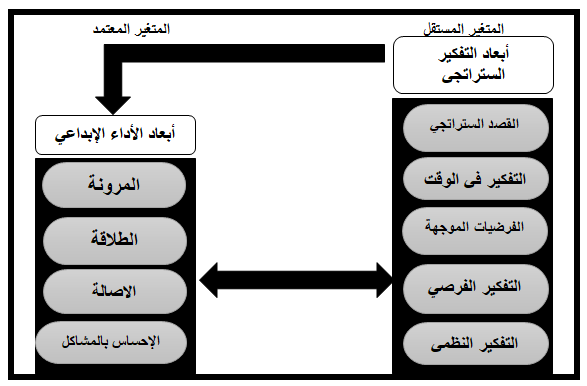
التنزيلات
منشور
كيفية الاقتباس
إصدار
القسم
الرخصة
الحقوق الفكرية (c) 2024 فيصل علوان الطائي، بهاء ميثم عبد حسين العلي

هذا العمل مرخص بموجب Creative Commons Attribution-NonCommercial-NoDerivatives 4.0 International License.
يحتفظ المؤلفون بحقوق الطبع والنشر لأوراقهم دون قيود.




